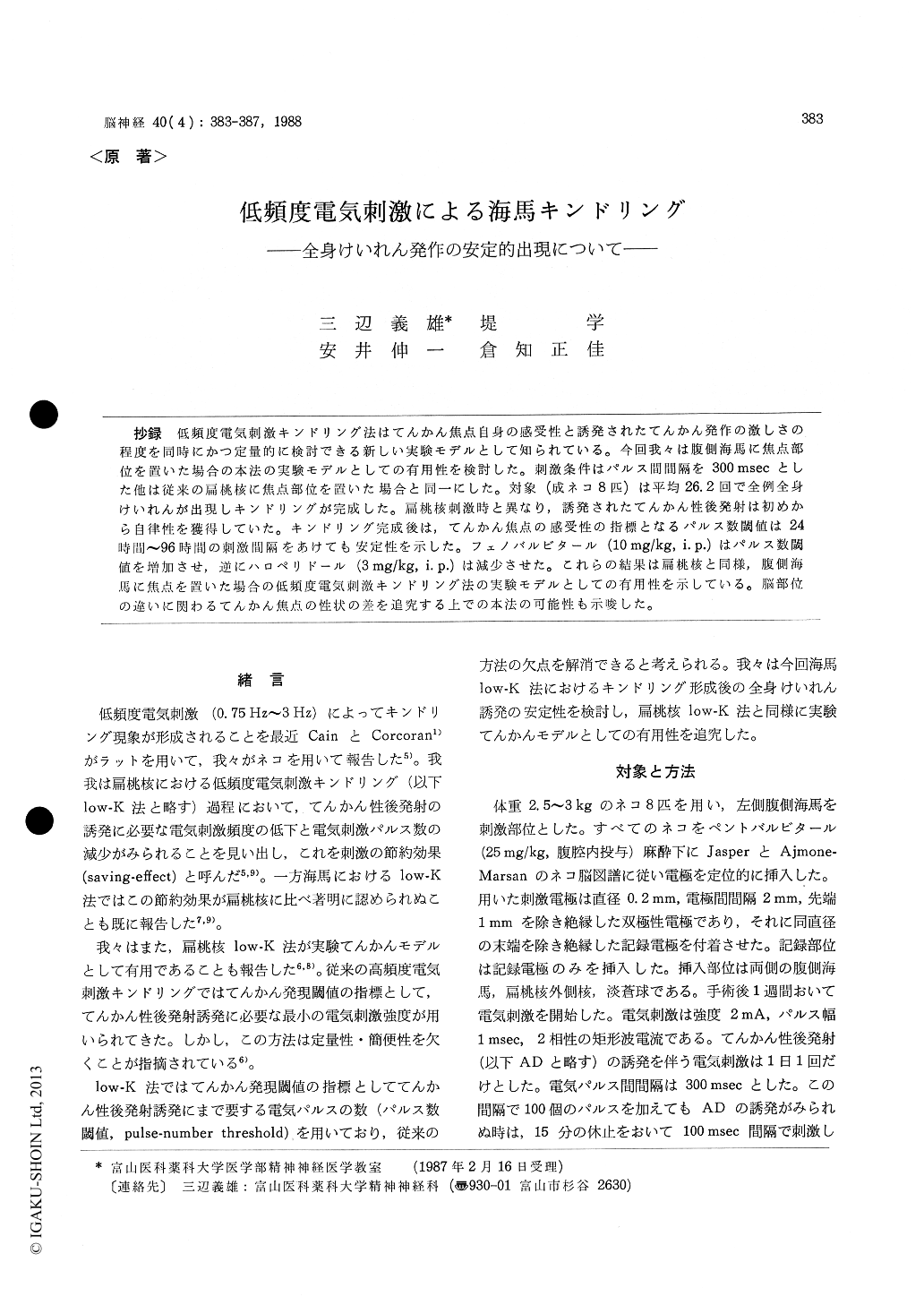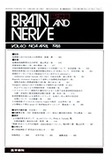Japanese
English
- 有料閲覧
- Abstract 文献概要
- 1ページ目 Look Inside
抄録 低頻度電気刺激キンドリング法はてんかん焦点自身の感受性と誘発されたてんかん発作の激しさの程度を同時にかつ定量的に検討できる新しい実験モデルとして知られている。今回我々は腹側海馬に焦点部位を置いた場合の本法の実験モデルとしての有用性を検討した。刺激条件はパルス間間隔を300msecとした他は従来の扁桃核に焦点部位を置いた場合と同一にした。対象(成ネコ8匹)は平均26.2回で全例全身けいれんが出現しキンドリングが完成した。扁桃核刺激時と異なり,誘発されたてんかん性後発射は初めから自律性を獲得していた。キンドリング完成後は,てんかん焦点の感受性の指標となるパルス数閾値は24時間〜96時間の刺激間隔をあけても安定性を示した。フェノバルビタール(10mg/kg, i. p.)はパルス数閾値を増加させ,逆にハロペリドール(3mg/kg, i. p.)は減少させた。これらの結果は扁桃核と同様,腹側海馬に焦点を置いた場合の低頻度電気刺激キンドリング法の実験モデルとしての有用性を示している。脳部位の違いに関わるてんかん焦点の性状の差を追究する上での本法の可能性も示唆した。
To assess the appropriateness of hippocampal low-frequency kindling as an experimental model of epilepsy, we stimulated, bipolarly, left ventral hippocampus of 8 cats with 2 mA biphasic square wave pulses (1 msec duration) once a day. The pulse-interval was set at 300 msec. Recording electrodes were inserted in right ventral hip-pocampus, bilateral amydala and bilateral globus pallidus. EEG was monitored before, during and after the delivery of stimulation. If the trigger-ing of epileptic afterdischarge was observed on EEG monitoring, the delivery of stimulation was stopped immediately.
Generalized convulsive seizures developed in all subjects within a mean of 26.2 days. In all seizures self-sustained epileptic afterdischarge, difined as epileptiform spikes three times the base line am-plitude with a frequency greater than the stimu-lating pulse-interval (300 msec) in the stimulated hipppocampus lead, was triggered abruptly. There-fore we could measure the number of stimulating pulses required for the triggering of epileptic afterdischarge, defined as pulse-number threshold, definitely in all cases. At the completion of kindl-ing the pulse-number threshold was measured at 12.3±0.9(±SE). After five generalized convulsions were induced we tested the stability of the pulse-number threshold and the duration of triggered epileptic afterdischarge. Both the two measuresdid not change statistically at the interstimula-tion interval from 24 hrs to 96 hrs.
In addition we carried out testing with antiepi-leptic and antipsychotic drugs. Phenobarbital (10 mg/kg, i. p.) increased the pulse-number threshold and the afterdischarge duration simultaneously. Haloperidol (3 mg/kg, i. p.), oppositely, decreased the pulse-number threshold and the afterdischarge duration.
Our results suggest that hippocampal low-fre-quency kindling would be a reliable experimental model of epilepsy in assessing the epileptic suscep-tibility of brain regions especially of the epileptic focus itself.
In the previous studies we proposed the use-fulness of amygdaloid low-frequency kindling as anexperimental model of epilepsy. It is known that amygdala and hippocampus are located in the limbic system and show the lowest seizure-genera-ting threshold in the brain regions suggesting their proneness to produce epileptic foci clinically. It's also known that these two structures are involved in the pathophysiology of various psychotic symp-toms, i.e. schizophrenia and affective disorders. We proposed that low-frequency kindling is a useful experimental model of epilepsy to examine the comparative effect and differences between the epileptic excitability of amygdala and hippocampus in carrying out the pharmacological study of anti-epiliptic or psychotropic drugs.

Copyright © 1988, Igaku-Shoin Ltd. All rights reserved.


